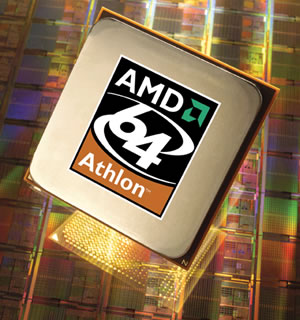AMD Athlon 64: the benchmarks


Platform support
Chipsets and motherboards are in short supply for the Athlon 64 compared to the situation when the original Athlon was launched. Similarly, everything is at an early stage as regards memory. Registered DDR400 modules -- which the Athlon 64 FX-51 requires -- are still very rare, although this situation may soon be rectified. Kingston is the first memory vendor to support the new AMD platform.
As far as operating system support is concerned, AMD will be pleased with the numerous Linux variants that already support its 64-bit architecture. Toward end of the year, the situation could improve further, as Microsoft plans to deliver an Athlon-64-optimised version of Windows XP Professional. The AMD ‘white box’ supplied for our tests came with a ‘pre-beta’ version of 64-bit Windows.
The first 64-bit applications are likely to be 3D games. Unreal Tournament 2004 is already optimised for the Athlon 64 family. Farcry, from German game developer Crytek (which sells through Ubisoft) should also be available as a 64-bit version. Also, Half Life 2, keenly awaited by many hardcore gamers, will likewise be optimised for the 64-bit AMD platform, it is rumoured.
It will take longer for business and professional applications to migrate to 64-bit versions. That may not be too bad, though, as the Athlon 64 -- in contrast to arch-rival Intel’s Itanium -- also runs 32-bit applications very fast. So fast that Intel was compelled to announce the Pentium 4 Extreme Edition -- a souped-up 3.2GHz P4 with 2MB of Level 3 cache.
Pentium 4 Extreme Edition
The fact that Intel has come up with the Pentium 4 Extreme Edition shows how seriously it takes AMD’s desktop 64-bit processors. Intel’s new chip is basically a Xeon with a P4-pinout, allowing it to fit in motherboards designed for the Pentium 4. The P4 EE, announced at the Intel Developer Forum (IDF), has an average energy dissipation of 94 Watts -- the maximum could be in excess of 100 Watts, a new record for a desktop CPU. AMD, by contrast, claims a maximum energy dissipation of 89 Watts for the high-end Athlon 64 FX-51.
Intel distributed samples of the Pentium 4 Extreme Edition to selected members of the press at IDF, for comparative testing purposes against the Athlon 64. According to Intel the new chip will be available in 30 to 60 days -- no pricing is available yet.
The new processors at a glance
| New AMD and Intel processors | |||
| Manufacturer | AMD | AMD | Intel |
| Processor | Athlon 64 FX-51 | Athlon 64 3200+ | Pentium 4 Extreme Edition |
| Clock speed | 2.2GHz | 2GHz | 3.2GHz |
| Level 1 cache | 128KB | 128KB | 8KB + 12KB mOps |
| Level 2 cache | 1MB | 1MB | 512KB |
| Memory bandwidth | 6.4GB/s | 3.2GB/s | 6.4GB/s |
| Socket type | 940 | 754 | 478 |
| Transistors | 105.9 million | 105.9 million | 169 million |
| Power dissipation | 89W (max) /70W (typical) | 89W (max) /66W (typical) | >100W (max)/94W (typical) |
| Die size | 193mm2 | 193mm2 | n/a |
Application performance
Business and Content Creation Winstone carry out typical tasks with mainstream and high-end applications respectively, such as converting video files or running a PowerPoint presentation. The following applications are used:
Business Winstone 2002
5 Microsoft Office 2002 applications (Access, Excel, FrontPage, PowerPoint and Word); Microsoft Project 2000; Lotus Notes; WinZip 8.0; Norton Anti-Virus; Netscape Communicator
Content Creation Winstone 2003
Adobe Photoshop 7.0; Adobe Premiere 6.0; Macromedia Director 8.5.1; Macromedia Dreamweaver 4; Microsoft Windows Media Encoder 7.01.00.3055; Netscape 6.2.3; NewTek's LightWave 7.5; Sonic Foundry Sound Forge 6.0
Internet performance
Internet performance, of course, is primarily dependent on the speed of your connection -- DSL versus dial-up, for example. But under identical connection conditions, processor speed can make a significant difference.
Video encoding
Encoding a video (duration 17m 12s) with different programs into different formats demonstrates a clear advantage for the Pentium 4 processors, with one exception. However, the P4’s advantage is slight (in the single-digit per cent range). Only with Ulead’s Video Studio 7 is the Athlon 64 FX-51 faster than the Intel processors. Obviously Ulead has not yet optimised its video application for the P4-architecture.
3D performance: Aquamark
When it comes to 3D performance, the CPU is a factor, but the performance of the graphics card and the speed of the AGP bus are also important. The Athlon 64 FX-51’s Nforce 3 platform is still relatively young, and chipset upgrades are likely to improve performance. The same goes for graphics card drivers. Software optimisations can also provide performance improvements -- of course, this is true for Intel too, although more optimisations have already been implemented for this more mature platform.
3D performance: 3DMark 2001/2003
Under Futuremark’s 3DMark 2001 and 2003 tests, the AMD and Intel processors deliver almost identical performance. Running at higher resolutions and activating anisotropic filtering (8xAF) and anti-aliasing (4xAA) produces no differences. In these modes of operation, the graphics card is the limiting factor.
3D performance: Comanche 4/Unreal Tournament
With Unreal Tournament and Comanche 4, the Athlon 64 FX-51 is respectively 18 and 10 per cent faster than the 3.2GHz Pentium 4. However, the Pentium 4 Extreme Edition almost matches the Athlon 64 at this resolution. At higher resolutions, the graphics card once again becomes the limiting factor.
3D performance: Splintercell
The tests with Splintercell do not show any significant differences between the processors. Only in the ‘Low quality’ mode at 1,024 by 768 does the new Athlon 64 FX-51 outperform the Intel processors.
3D performance: Quake 3
Workstation performance: Viewperf & SPEC APC
In the Viewperf tests Data Explorer (DX) and Design Review (DRV), the Athlon 64 FX-51 is up to 10 per cent faster than the Pentium 4. The three CPUs tested are pretty much level in the remaining tests.
Workstation performance: Maya 5, 3D Studio Max 5.1
With Maya 5 the Athlon 64 FX-51 acquits itself well, but with 3D Studio Max it lags behind the Intel competition.
Workstation performance: Cinema 4D, Lightwave, Bryce
If a highly-optimised SSE2 application such as Cinema 4D is used, the Pentium 4 has an advantage. The new Athlon 64 FX-51 is faster than the Pentium 4 processors when running older software such as Bryce 5.
Conclusion
With its 64-bit processor, AMD is right where it wants to be -- at the cutting edge of technological development. The Athlon 64 FX-51 may not always outperform Intel’s new Pentium 4 Extreme Edition, which Intel distributed to some journalists specifically for comparisons such as this. However, AMD’s new desktop processors offer something that Intel does not: 64 bits.
Don’t expect miracles from this technology: 64-bit may be double 32-bit, but programs do not necessarily run twice as fast. The advantage of 64-bit technology is the size of the addressable memory. Whereas 32-bit processors cannot use any more than 4GB of memory effectively, the 64-bit AMD processors can handle up to 1 terabyte, providing a high degree of future-proofing.
But who needs more than 4GB in a desktop PC? (A question frequently asked by Intel). Even now the operating system is held back by 32-bit technology. With Windows, the directly usable memory is currently limited to 2GB per process. By cheating (Boot.ini-Switch /3GB), this can be extended to 3GB, but that’s as far as you can go. The average memory complement of today’s new PCs is about 512MB, with many observers expecting this to double for 2004. So Intel will not be offering a 64-bit processor for desktop PCs, as PR representatives at the recent IDF stressed: we’re in a period of transition; wait for the Prescott CPU; who needs 64-bit?
Even so, at some point, the standard memory complement will exceed 4GB. And when it does, users will recall that it was AMD, rather than Intel, that set the pace. After all, the various extensions to Intel’s 32-bit processor architecture were little used at first, but are now widely adopted -- MMX, SSE and SSE2 are examples.